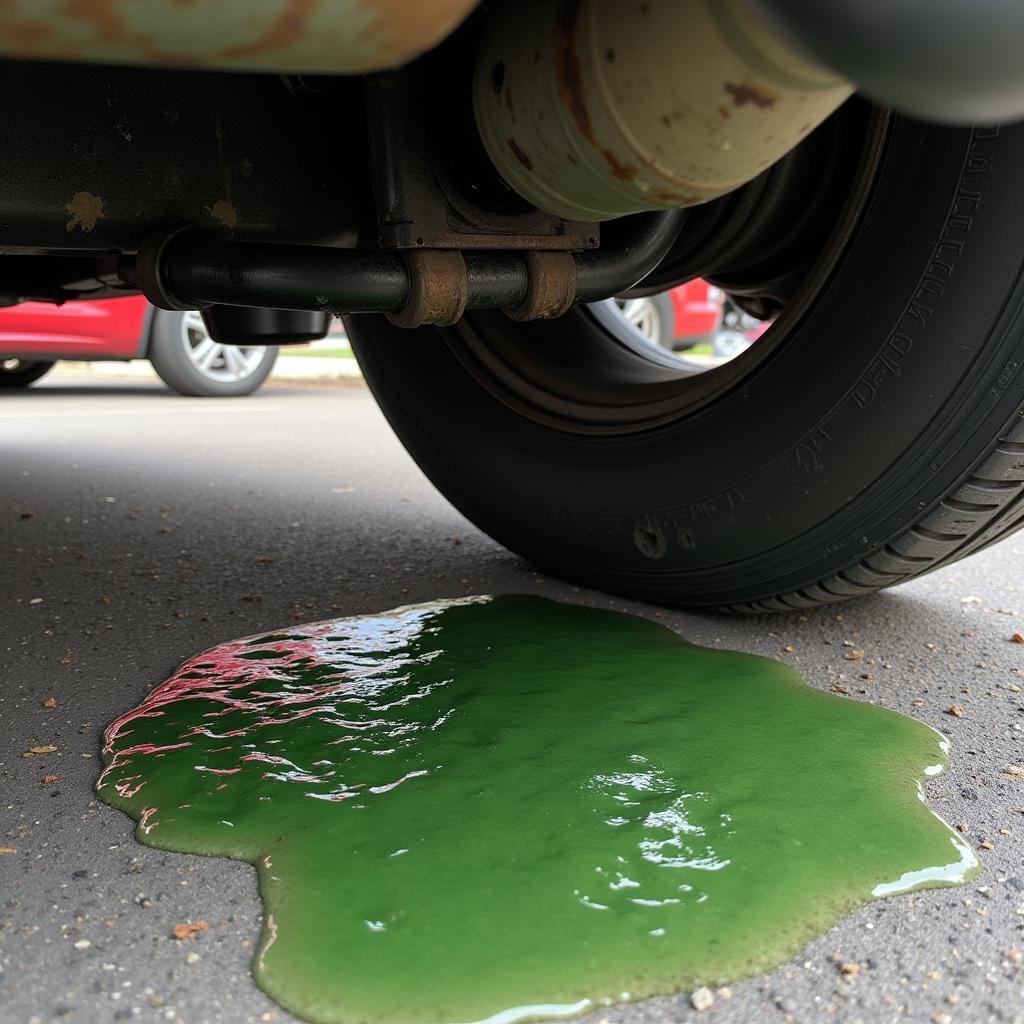Diagnosing a car water pump problem can be tricky, but with a little knowledge and attention to detail, you can identify the culprit and prevent costly repairs. A faulty water pump can lead to overheating, engine damage, and even complete engine failure. This guide will equip you with the tools and knowledge to Diagnose Car Water Pump Problems effectively.
Common Symptoms of a Failing Water Pump
One of the first steps in diagnosing a car water pump problem is recognizing the common symptoms. These include:
- Overheating: A failing water pump won’t circulate coolant effectively, leading to engine overheating.
- Coolant leaks: Look for puddles of coolant under your car, especially near the water pump area. The color of coolant varies but is typically green, orange, or pink.
- Whining noise: A worn-out bearing in the water pump can create a high-pitched whining sound, often increasing in pitch with engine speed.
- Steam from the radiator: While steam can indicate other issues, it can also be a sign of a failing water pump causing overheating.
- Low coolant levels: If you’re constantly having to top off your coolant, it could signify a leak, possibly originating from the water pump.
Similar to basic car problems and solutions, early detection and diagnosis can save you a lot of hassle down the road.
 Car Water Pump Leak Detection
Car Water Pump Leak Detection
What Causes Car Water Pump Problems?
Several factors can contribute to car water pump failure:
- Wear and tear: Like any mechanical component, water pumps have a lifespan. Over time, the bearings and seals can wear out, leading to leaks and noise.
- Corrosion: Coolant contains chemicals that can corrode the water pump housing and impeller, reducing its effectiveness.
- Contamination: Debris in the cooling system, such as rust or sediment, can damage the water pump impeller and seals.
- Improper installation: A poorly installed water pump can lead to premature failure.
Understanding the root cause of the problem, much like understanding car wreck engine problems, helps prevent future occurrences.
 Worn Water Pump Impeller
Worn Water Pump Impeller
How to Diagnose a Car Water Pump Problem Yourself
Before taking your car to a mechanic, you can perform some basic checks yourself:
- Visual inspection: Check for visible leaks around the water pump. Look for signs of corrosion or damage to the housing.
- Check the coolant level: Make sure the coolant level is within the recommended range. Low coolant can be a symptom of a leak.
- Listen for unusual noises: Start the engine and listen for any whining or grinding noises coming from the water pump area.
- Pressure test: You can purchase a pressure tester to check for leaks in the cooling system. This is a more definitive way to pinpoint a water pump leak.
This approach can also be helpful when trying to how to diagnose a car engine problem.
When to Seek Professional Help
While some basic checks can be done at home, it’s often best to consult a qualified mechanic for a thorough diagnosis. This is especially important if:
- You’re not comfortable working on your car’s cooling system.
- You suspect a more complex issue beyond the water pump.
- You’ve performed basic checks and still can’t identify the problem.
Just as with mid engine car problems, sometimes professional expertise is required.
Expert Insights
“Regular maintenance, including coolant flushes and checks, can significantly extend the life of your water pump,” says automotive expert, John Smith, ASE Certified Master Technician. “Addressing small leaks promptly can prevent bigger problems down the road.”
“Ignoring a failing water pump can lead to catastrophic engine damage,” adds Jane Doe, another experienced mechanic. “The cost of replacing a water pump is significantly less than rebuilding an engine.”
Conclusion
Diagnosing car water pump problems involves recognizing the symptoms, understanding potential causes, and performing basic checks. While DIY diagnosis is possible, consulting a professional is often the best approach for complex issues. By addressing water pump problems promptly, you can avoid costly repairs and keep your car running smoothly.
For expert assistance with your car’s cooling system or any other automotive needs, contact AutoTipPro at +1 (641) 206-8880. Our office is located at 500 N St Mary’s St, San Antonio, TX 78205, United States.
FAQs
-
How often should I replace my water pump? There’s no set replacement interval, but it’s generally recommended to replace the water pump along with the timing belt, usually every 60,000 to 90,000 miles.
-
Can I drive with a bad water pump? No, driving with a bad water pump can lead to overheating and severe engine damage.
-
How much does it cost to replace a water pump? The cost varies depending on the make and model of your car, but it typically ranges from $300 to $800.
-
What is the function of a water pump? The water pump circulates coolant through the engine to keep it at the optimal operating temperature.
-
How can I prevent water pump problems? Regular maintenance, including coolant flushes and checks, is crucial for preventing water pump problems. Addressing small leaks promptly can also help.
-
What are the signs of a seized water pump? A seized water pump will often result in complete coolant loss and rapid overheating. You may also hear a loud screeching noise.
-
Can a bad thermostat cause similar symptoms to a bad water pump? Yes, a faulty thermostat can cause overheating, which can be mistaken for a water pump problem. It’s important to diagnose both components correctly.
This situation might remind you of car problems with a hummer, where early diagnosis is key.






Leave a Reply